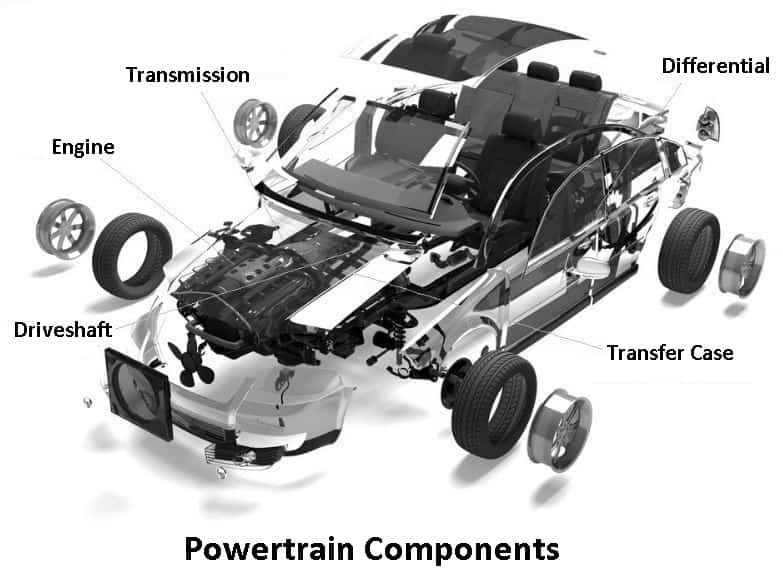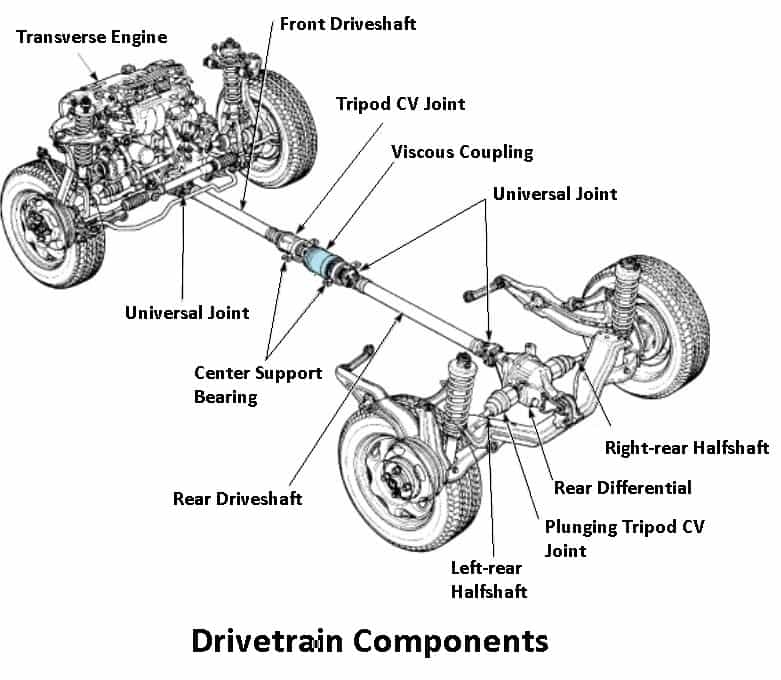In this article, you will learn what is powertrain vs drivetrain? their components and difference are explained with Pictures.
If you need a PDF file? Just download it at the end of the article.
Powertrain vs Drivetrain
Most people might not know about the benefits of comparing powertrain vs drivetrain. However, recognizing the differences between the two will benefit you when buying a vehicle or having a technician check for a problem.
Basically, powertrain and drivetrain are some widespread terms that get thrown around in the automobile. Now you may wonder what each of these terms actually means? Are they the same or different?
Understanding the terms powertrain and drivetrain can also help you on your next trip to the mechanic. Furthermore, the more you know how an automobile is operated, the better you can appreciate the real wonder.
To put these words simply, powertrain and drivetrain do essentially the same thing. They generate kinetic energy to keep your vehicle in motion. You would have never thought how vital these dynamic components are. Let’s know them in detail.
Read Also: What is the difference between Drum and Disc Brake? [Explained]
What is Powertrain?

The powertrain is everything that provides power to the vehicle. In other words, the powertrain is a combination of every component that propels the vehicle. Typically, it draws power from the engine and transmits it to the wheels on the ground.
A properly treated powertrain system will always perform optimally for the vehicle. It will have proper fuel and oil consumption efficiency which will allow the vehicle to run smoothly.
The powertrain mainly consists of all those pieces and parts that convert the combustion from the engine to the actual speed to propel the vehicle. Therefore, its sole purpose is to convert kinetic energy into propulsive motion. If one of these components fails, the car may face an unusual rattle or shaking.
Components of Powertrain
Powertrain mainly consists of major components which are listed below,
- Engine
- Transmission
- Driveshaft
- Axles
- Differential
#1 Engine
An engine is part of the powertrain designed to convert one or more types of energy into mechanical energy. Since it is the heart of your vehicle, an engine generates the power to drive the car. An engine mainly consists of pistons that move up and down inside a cylinder and a crankshaft that converts reciprocating motion into rotational motion.
#2 Transmission
Transmission is a primary part of every car that ensures the proper amount of power is transmitted to the wheels. Like a gearbox, it takes power from the engine and adjusts it according to driving conditions, eventually transferring it to the wheels.
#3 Driveshaft
Also known as the propeller shaft, its function is to transfer torque from the transmission to the wheels. To do this, it would have to be driven from different angles and its length would have to be changed to accommodate the speed of the suspension.
#4 Axles
Axles are another vital part of the powertrain. It is mainly located between the wheels. Its function is to handle the vehicle’s weight, and it also rotates and transmits engine power to the wheels.
#5 Differential
It is another essential part that is used with the rear axle. Differential systems offer each rear wheel to turn at a different speed while taking a turn. For example, it is significant when turning a corner because the outer wheel needs to spin faster than the inner wheel.
What is Drivetrain?

The drivetrain is everything in the powertrain except the engine. Simply put, this is a set of parts that interact with the engine to move the wheels and push them into motion. The drivetrain often consists of the transmission, differential, driveshaft, axle, CV joint, and wheels.
In this, the engine generates power to power the flywheel. The flywheel operates the transmission to control the amount of power distributed to other parts of the drivetrain. Now, the driveshaft rotates to power differential, and then through it distributes power to all those driveshaft parts and the wheels spin.
Read Also: What are the different Types of Tires for Cars? [Explained]
Components of Drivetrain
Drivetrain mainly consists of major components, which are listed below,
- Transaxle
- Constant velocity joint
- Half shaft
- Universal joint
- Driveshaft
- Differential
#1 Transaxle
This component is usually located in four-wheel-drive vehicles. As the name suggests, it acts as both transmission and an axle. Its one end is connected to the clutch or torque converter depending on the transmission type of vehicle. Its other end is connected to either the differential or another set of gears.
#2 Constant Velocity Joint (CV joint)
The function of a constant velocity joint is to deliver power through a variable angle. These are an essential part of the transmission system, as they transfer this power at a constant rotational speed and actually have less friction.
#3 Half Shaft
It is nothing but a driving axle that is divided into two parts to be used on both wheels. One end is connected to the differential and the other one is connected to the wheel.
#4 Universal Joint
A universal joint is a critical component that joins two shafts that have inclined axes, which means there is an angle between the axes. These are used in the rear-wheel drive to connect the transmission to the propeller shaft and the propeller shaft to the differential.
Read Also: What is the function of a knuckle joint in your car?
Difference Between Powertrain vs Drivetrain
Although we often see that the terms “powertrain” and “drivetrain” are used interchangeably, they are slightly different. The following points clear your doubts regarding the difference between them.
| Powertrain | Drivetrain |
|---|---|
| The powertrain mainly consists of an engine and a drivetrain. | The drivetrain consists mainly of the kinetic parts, but not the engine. |
| The term powertrain refers to the power going to the wheels. | Whereas the term drivetrain is for all the parts that your vehicle’s mechanics employ to move. |
| The powertrain consists of transmission. axle, engine, driveshaft, wheels, and differential. | The powertrain consists of a transaxle, CV joint, half shaft, universal joint, driveshaft, and differential. |
Drivetrain and powertrain mechanisms differ greatly. This will depend on how your vehicle is configured. The powertrain and drivetrain for a rear-wheel-drive vehicle are different from those for a front-wheel-drive car. In addition, they will differ also between two-wheel drive and all-wheel drive.
Conclusion
Now, I hope I’ve covered everything you were looking for about “powertrain vs drivetrain”. If you still have any doubts or questions regarding this topic, leave a comment below I’ll definitely reply. If you liked it, then share this with your friends.
Want free PDFs direct to your inbox? Then subscribe to our newsletter.
Download PDF of this article:
You might like to read more about auto enggs:
I am one of the persons who want to have knowledge of this, it’s good an article.
We welcome you. Thanks for your feedback.